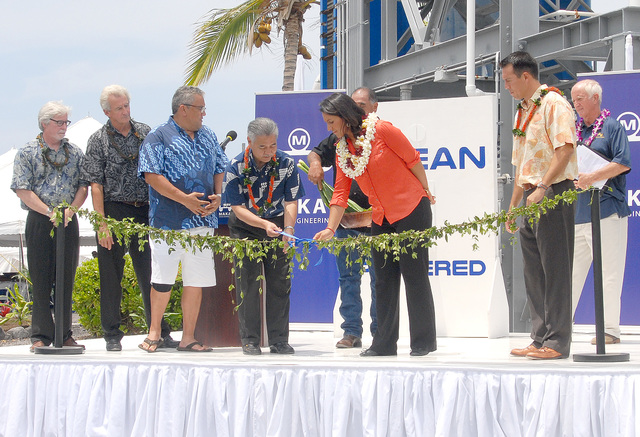Ocean water is finally generating a shock in North Kona.
Ocean water is finally generating a shock in North Kona.
Jokes about fire and sparks notwithstanding, Gov. David Ige flipped a giant white switch at the Ocean Energy Research Center power production tower on Friday. The rising hum of the turbine — a sound like a jet warming up — signaled that electricity production had begun at the OTEC oceanside facility in North Kona.
The whining turbine is slated to continuously produce 100 kilowatts — enough to power 120 homes — and the noise marked the launch of the world’s largest operational ocean thermal energy plant and the only one hooked up to a U.S. grid.
The technology uses both warm ocean surface water and cold deep sea water to generate power. The warm water heats and evaporates a liquid whose pressurized vapor runs the turbine, and the cold water pumped from deep in the ocean condenses the liquid so the cycle can repeat. The Makai Ocean Engineering project is aimed at testing and refining technology with an eye to putting it to much greater commercial use in the future.
Ige, an engineer, said OTEC was exciting to himself personally. Much renewable energy generation in the islands is intermittent and relies on the sun shining or the wind blowing — but deep sea water is a reliable, 24-hour source that doesn’t depend on the vagaries of weather, Ige said.
“OTEC is a consistent power source, key to 100 percent renewability,” Ige said. “This facility really establishes Hawaii as the center of OTEC in the country as well as the world.”
The governor was one of numerous dignitaries who feted the kick-off of power production at the end of the road at the Natural Energy Laboratory of Hawaii Authority. Mayor Billy Kenoi and Congresswoman Tulsi Gabbard were among those who lauded the project’s potential for helping make the island energy-independent. Also in attendance was a delegation from Okinawa, whose prefecture has invested in the project.
“The question is whether it can be scaled and made economically viable,” Ige said after a tour of the facility.
The facility is key to building confidence in OTEC as a viable energy source, Ige said, noting that the Big Island is perfectly situated to tap deep seawater because of its steeply inclined seabed.
The project is a multi-party collaboration that includes Lockheed Martin, the Hawaii Natural Energy Institute, the Okinawa Prefecture and the Office of Naval Research. The Navy has pumped $16 million into research and development of the plant since 2009, including funds to build the tower itself, whose construction cost runs in the $2 million to $3 million range.
Rich Carlin, head of the Sea Warfare and Weapons Department at the Office of Naval Research, said the plant is the first step toward a commercial operation. Carlin touted future plans for a 100 megawatt offshore plant as important to both renewable energy interests and the Navy.
Makai Ocean Engineering hopes to build a 1 megawatt plant within five years through a partnership with Okinawa — part of a plan of stepping up to much larger power plants in the future, said Adam Wong, chairman of the board of directors for the company.
The beginnings of OTEC and Makai can be traced back to the 1970s.
The electricity enters the Hawaii Electric Light Co. grid, but will be used within the Hawaii Ocean Science and Technology Park, so HELCO is not actually purchasing the energy.
In an interview covering an unrelated topic after the tour, Ige said he continues to press for installation of U.S. Customs agents at Narita International Airport. The agents would allow Japanese visitors to fly straight to neighbor island airports like Kona’s without having to first pass through customs in Honolulu.
“From my conversations with people in the travel industry in Japan, they want preclearance in Narita,” Ige said.
U.S. Customs and Border Protection gave approval in May to adding Narita to its list of foreign airports with U.S. Customs. But it could be months while a treaty between the two countries is worked out and an agreement is forged to address how the customs would be structured, Ige said.
“It would require a lot of operational changes at Narita and basically the installation of a U.S. customs facility there,” he said.

